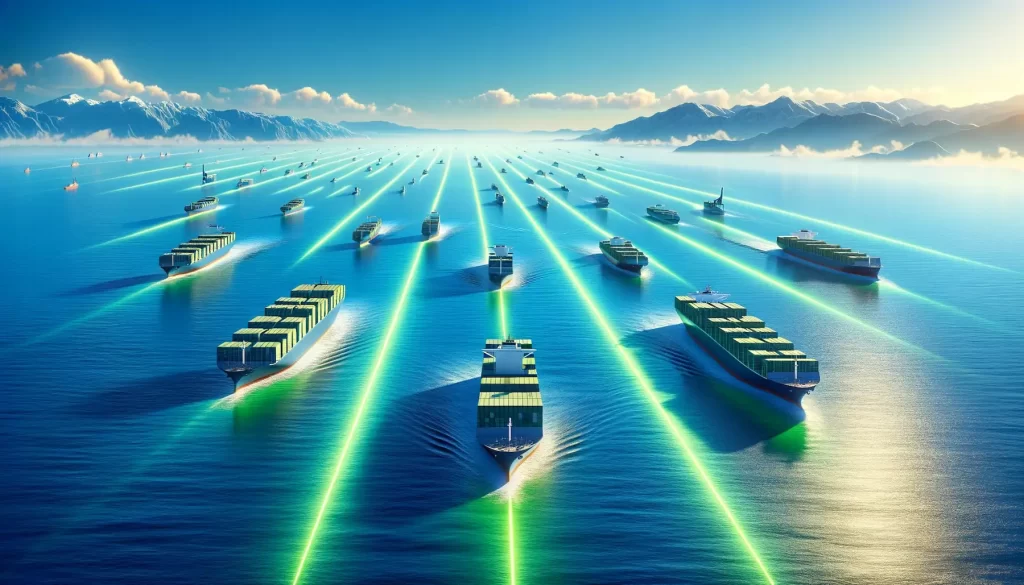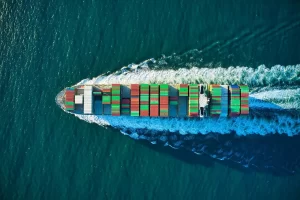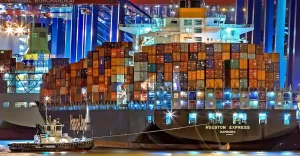Green shipping corridors can accelerate adoption of low-carbon fuels in the maritime sector, but greenwashing of green shipping corridors might erode their climate impact. What is driving greenwashing, what are the consequences, and how might we prevent it?
The Conference of the Parties to the United Nations Framework Convention on Climate Change, better known as COP, held its 28th meeting during the first two weeks of December. At COP28, there was an update on The Green Shipping Challenge. This initiative, co-organized by the US and Norway, was first launched at COP27. It aggregates public and private announcements in maritime decarbonization. During COP28, there were 59 announcements, 23 of which were related to green shipping corridors. Clearly, this is a hot topic.
Green shipping corridors were popularized in late 2021 with the introduction of the Clydebank Declaration at COP26. This pledge commits signatories to establish at least six green shipping corridors by 2025. By COP27, around twenty were announced. By COP28, this number had doubled, and there are now 44 green corridor initiatives across the globe. However, none of these are implemented yet. As the number of announced corridors grows quickly, it prompts a question: Are all of these initiatives legitimate? Green shipping corridors can accelerate the adoption of low-carbon fuels in the maritime sector, but the greenwashing of green shipping corridors might erode their climate impact
The Promise of Green Shipping Corridors
Green shipping corridors are defined within the Clydebank Declaration as ‘zero-emission maritime routes between two (or more) ports.’ There is no widely accepted definition (more on this later), and each corridor is subtly different from the next. By focusing efforts on specific trade lanes and addressing the unique regional issues with local stakeholders, green corridors are meant to accelerate the adoption of low-carbon marine fuels and similar technologies. The routes can be specific to certain ship types, but few, if any, corridors expect all ships on a nominated route to be low-emission.
According to the Global Maritime Forum’s last annual report, released in December 2023, there are 44 green shipping corridor projects underway. However, none of these corridors are implemented yet. In fact, nearly all are in various stages of planning. Many are undergoing ‘pre-feasibility’ assessments, a low-risk way of investigating viability.
One of the furthest along in development is the corridor announced between the Ports of Los Angeles, Long Beach, and Shanghai. It’s hard to determine which corridors are legitimate efforts versus those that are merely media fanfare; time will tell.

Greenwashing in Maritime
Greenwashing is the practice of making something appear more environmentally friendly than it really is. This may involve misleading claims or marketing strategies that exaggerate an environmental commitment, or it could simply entail making claims with no intent to fulfill them.
Greenwashing is not new to the maritime sector. There have been numerous instances where shipping companies, ports, or other stakeholders have touted non-existent benefits or have been accused of greenwashing. For examples, see here, here, and here. Stakeholders may have compelling reasons for announcing a green corridor, even if there is no serious intent behind it.
What Causes Greenwashing of Green Shipping Corridors
Green shipping corridors are still new, and as is common with new developments, there is confusion about how to support and regulate them productively. There is no International Green Shipping Corridor Police Force to provide regulatory oversight and enforcement. There aren’t even regulations to enforce. That may change one day, as seen in this example from the EU. But for now, there is a very real risk of greenwashing.
Greenwashing of green shipping corridors results from four main drivers: ambiguous definitions, competition, public relations, and low barriers to entry.
Ambiguous Definitions
Frameworks and definitions for green shipping corridors abound. For example, your author contributed to the development of the US Green Shipping Corridor Framework. Each framework is subtly different from the others, and all leave room for interpretation on important questions, such as:
- Do corridors have to be implemented by a specific date?
- Does shipboard carbon-capture paired with heavy fuel oil count?
- What percentage of emissions reduction qualifies it as a green corridor?
- How many ships on the route have to participate?
- How are the emissions measured, and what is the baseline for comparison?
If these questions are answered in the planning stages, the answers are not consistent across routes. They may use different metrics, methods of measurement, and dates, which makes comparing corridors in any meaningful way challenging. A lack of standardization and subjective interpretations allows for diluted climate goals.
Low Barrier to Entry
Almost anyone can announce a green corridor. An announcement is simply a signal of intent, and it is up to the involved parties to define their own terms. This low barrier to entry allows stakeholders to design a corridor in a low-risk, non-committal way, with plenty of lead time. As DNV points out in their 2023 Energy Transition Outlook, corridor development can take up to eight years.
Public Relations
Green shipping corridors are ultimately about improving sustainability in the maritime sector and reducing greenhouse gas emissions. It’s no secret that sustainability provides significant public relations benefits, whether through better brand recognition or positive media attention. Green corridors are not yet commonplace. When a new one is announced, it still tends to receive shout-outs at significant events like COP. But as more corridors are announced, there will be diminishing marginal public relations benefits for all.
Competition
Ports, terminal operators, carriers, fuel producers, and other maritime stakeholders operate in a tough business. Maritime trade is inherently cyclical, highly regulated, extremely complex, and subject to the whims of unpredictable geopolitical trade wars. Gaining an edge over competitors can be extremely valuable. Ports are foundational to a green shipping corridor; consider competition from their point of view.
For some ports, location is their most important competitive advantage. For others, it can be a limitation, and it’s not easily changed. To differentiate, ports have to come up with other benefits and services to attract new customers. Touting a port’s involvement in a green shipping corridor is just one such method.
As more ports get involved, this places increasing pressure on others to make similar announcements to stay competitive. However, because a port can set its own definition, it can receive the benefits of announcing a corridor with minimal commitment.
Some ports are eligible to receive federal funding. The Clydebank Declaration has 27 countries as signatories, including the United States, Singapore, Germany, and Australia. This international pledge is a strong signal from governments that ports might interpret as new potential funding streams, thereby creating a race to curry favor with government agencies through green corridor announcements.
How to Spot Greenwashing of Green Shipping Corridors
There are no clear-cut rules for spotting greenwashing. However, some aspects to consider might include the timeframe for action, the technologies or fuels being used, baseline years for comparison, members of the maritime value chain involved, committed funding, and the emissions reduction goals. These are fairly basic elements that every project should be able to disclose if they are serious about their efforts. The absence of any detail at all might also be a telltale sign.
Consequences of Greenwashing
Greenwashing of green shipping corridors is not harmless. Green corridors are still a relatively new concept and not enough time has passed to assess the implications of their greenwashing, but potential consequences might include:
Slowing Climate Progress
With so many initiatives underway, it creates the perception of progress. But this may be an illusion. This misguided perception reduces the sense of urgency and might actually slow progress if enough of the projects are illegitimate.
Resource Misallocation
There are limited resources that must be used widely in the energy transition. Illegitimate green shipping corridors may divert precious resources away from more impactful projects.
Undermining
Greenwashing of green shipping corridors may unfairly discredit legitimate projects, making it harder for those efforts to distinguish themselves and promote public cynicism of all projects. As more green shipping corridors are announced, it makes each individual project seem more common in a diminishing marginal utility kind of way. If everyone is doing it, there is nothing special about each individual initiative. There are very valuable network benefits from linking together disparate green corridors, but this is true only for legitimate efforts.
Preventing Greenwashing of Green Shipping Corridors
There are ways to mitigate greenwashing. These include transparency, using third-party verification and auditing, standard reporting on green corridor progress, and stakeholder education. Taking a look under the hood at the inner workings of something builds trust, ensuring you aren’t dealing with a Mechanical Turk, and facilitates collaboration. Sharing lessons learned, challenges, and data can help move everyone forward and is the first step towards standardization. For instance, the Silk Alliance corridor was praised by the Global Maritime Forum in their 2023 annual report for their transparency, which has helped identify pain points for other corridors that are not as far along.
Progress reporting is best when verified by an unbiased third-party. While there are a handful of NGOs supporting green shipping corridor development, few, if any, are in a good position to provide this level of unbiased verification or auditing. There are numerous organizations that provide similar roles for corporate ESG audits, but this seems to be an unfilled niche at present. Such verification bodies would require some form of regulatory guidance or standard reporting. Piecemeal reporting by each green shipping corridor, using different metrics and timelines, will make any systematic comparison amongst them very challenging.
Finally, and perhaps most importantly, the greenwashing of green shipping corridors can be prevented by stakeholder education and awareness. Asking the hard questions and ensuring we push ourselves towards ambitious, yet realistic goals, through self-policing, is key.
Plotting the Course
Continued growth of green shipping corridors will undoubtedly lead to greenwashing. There are strong incentives for stakeholders to announce corridors, especially when there are low barriers to entry and the ability to choose their own terms of engagement. However, the consequences of greenwashing can be counterproductive to the broader goals of green shipping corridors. It may decelerate progress in decarbonizing maritime emissions instead of accelerating it.
To mitigate the greenwashing of green shipping corridors, stakeholders need to be transparent in their goals and progress towards achieving those goals. This should preferably involve using third-party verification and auditing bodies that work from common frameworks and definitions. Green shipping corridors could be a powerful mechanism to help decarbonize shipping, but only if they have committed stakeholders striving for ambitious and realistic emissions reduction goals.
References
- Clydebank Declaration, UK Department for Transport. Accessed Dec 30, 2023
- Maritime Forecast to 2050, DNV, 2023.
- Ports of Los Angeles, Long Beach, and Shanghai unveil Implementation Plan Outline for first trans-Pacific green shipping corridor, C40, September 2023. Accessed Dec 30, 2023
- Annual Progress Report on Green Shipping Corridors, Global Maritime Forum, December 2023.
- Green Shipping Corridor Hub, Mission Innovation Zero-emission Shipping Mission
- Green Shipping Corridors Framework, US Department of State. Access Dec 30, 2023.
- EU to ban greenwashing and improve consumer information on product durability. European Parliament News, September 2023. Accessed Dec 30, 2023




